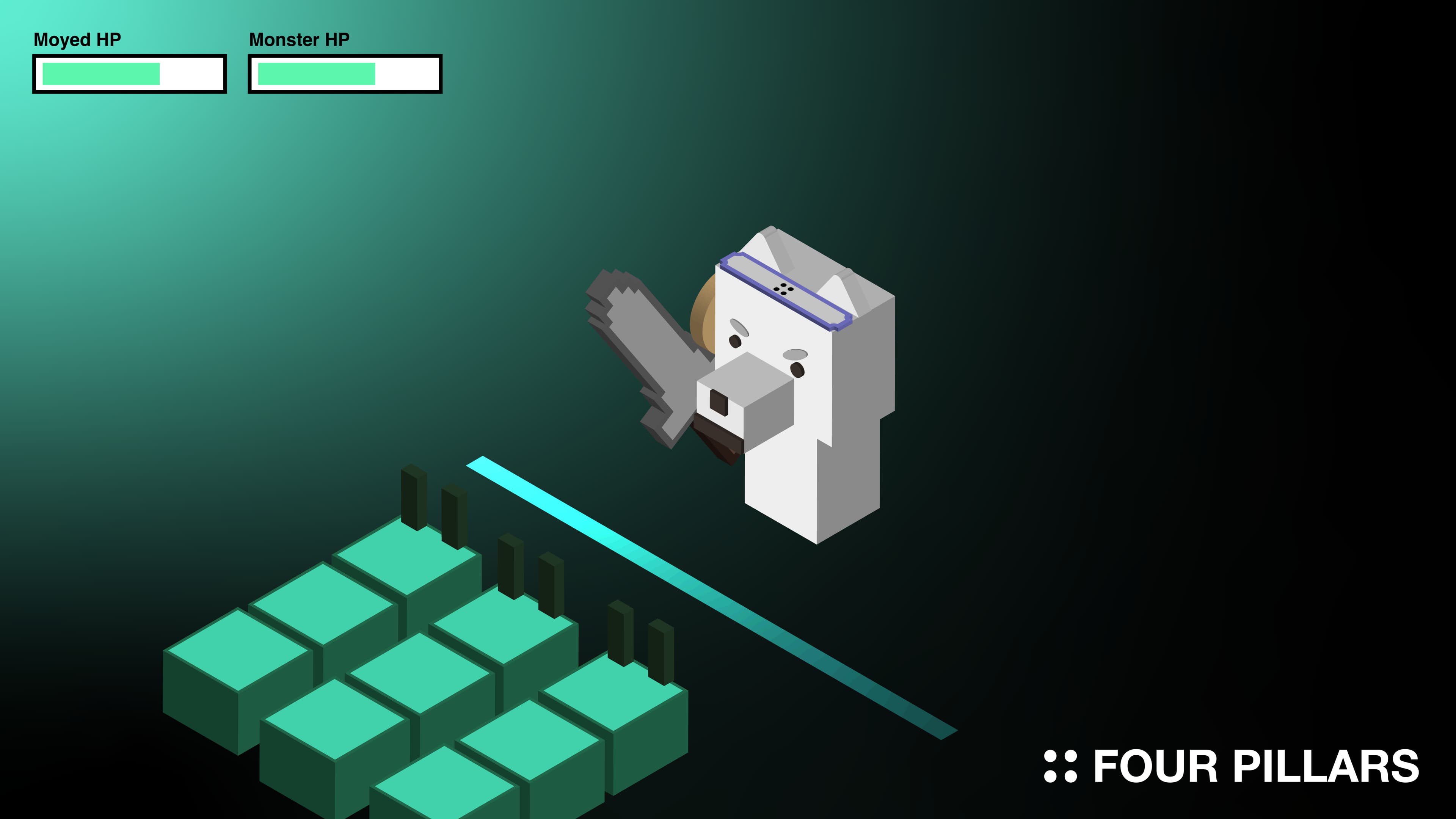

It seems like there are new on-chain games every day. Through this series with Iskra, I'll be reviewing various on-chain games that are released or available for playtesting that month. Please keep in mind that my thoughts on these games are very personal, and if you have a favorite on-chain game you'd like to see me review, please let me know on Twitter.
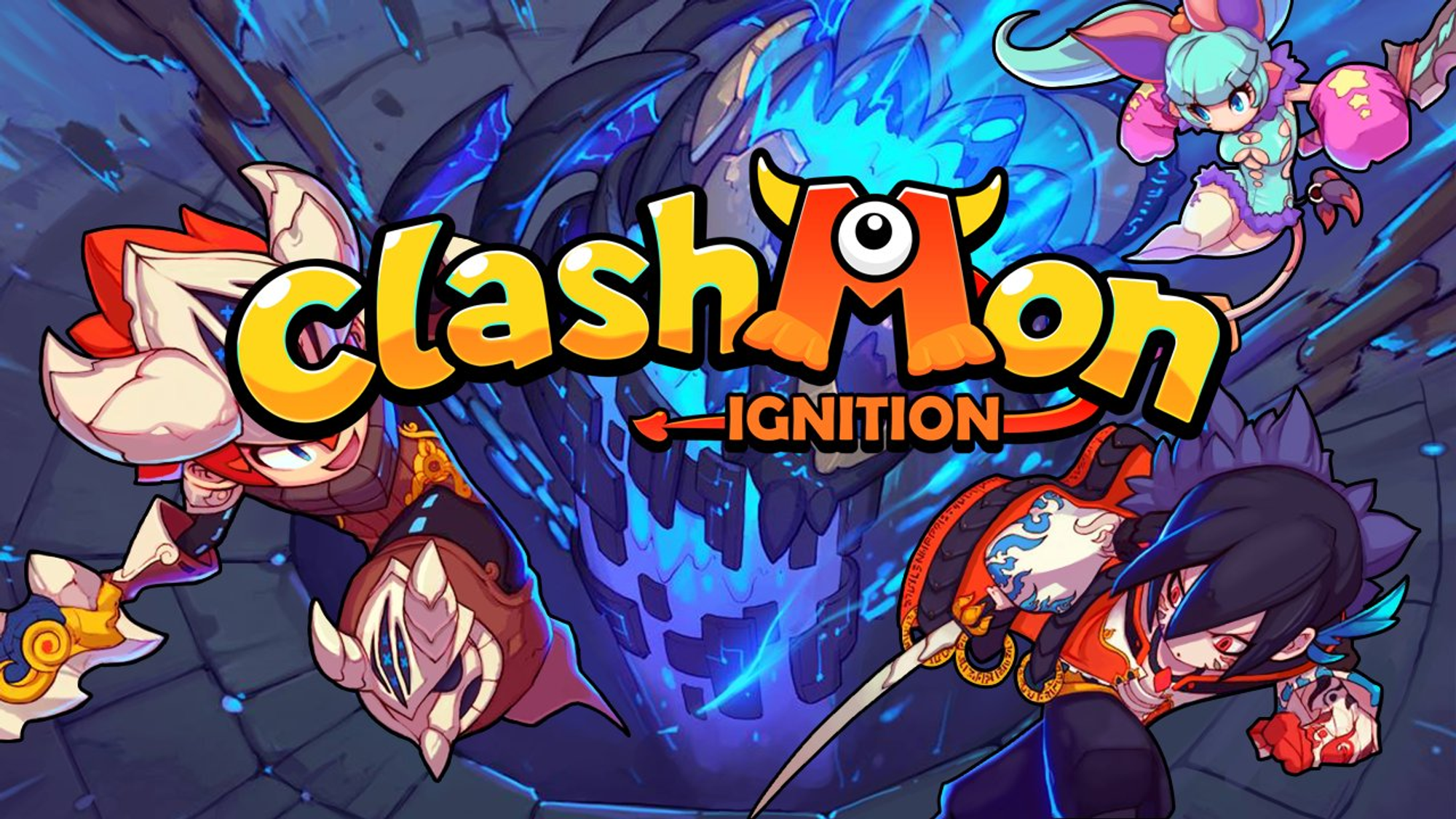
Clashmon Ignition is a collectible RPG game developed by Iskra itself that uses a base chain. Clashmon Ignition officially launched on September 26th, and has been running an Official Launch Event for about a month.
Unlike previous releases from third-party development studios, Clashmon Ignition is a game developed in-house at Eskra. For more information about Iskra, please refer to our previous article on Iskra.
Clashmon Ignition main contents are as follows.
1.3.1 Arena
A PvP game mode where you can build your own team for a chance to win certain rewards or mystery boxes. You pay $TORCH, our native token, as an entry fee, and earn more $TORCH if you win. As you accumulate wins, you will accumulate Victory Points, and the more Victory Points you have, the more rewards you will receive.
1.3.2 Championships
Each Championship lasts about two weeks and requires a ticket to participate. You can get one free ticket every day, complete quests, or buy them in the Bank. As you accumulate wins, you'll earn points, which will unlock stronger opponents. Rewards are allocated based on your final ranking in each round.
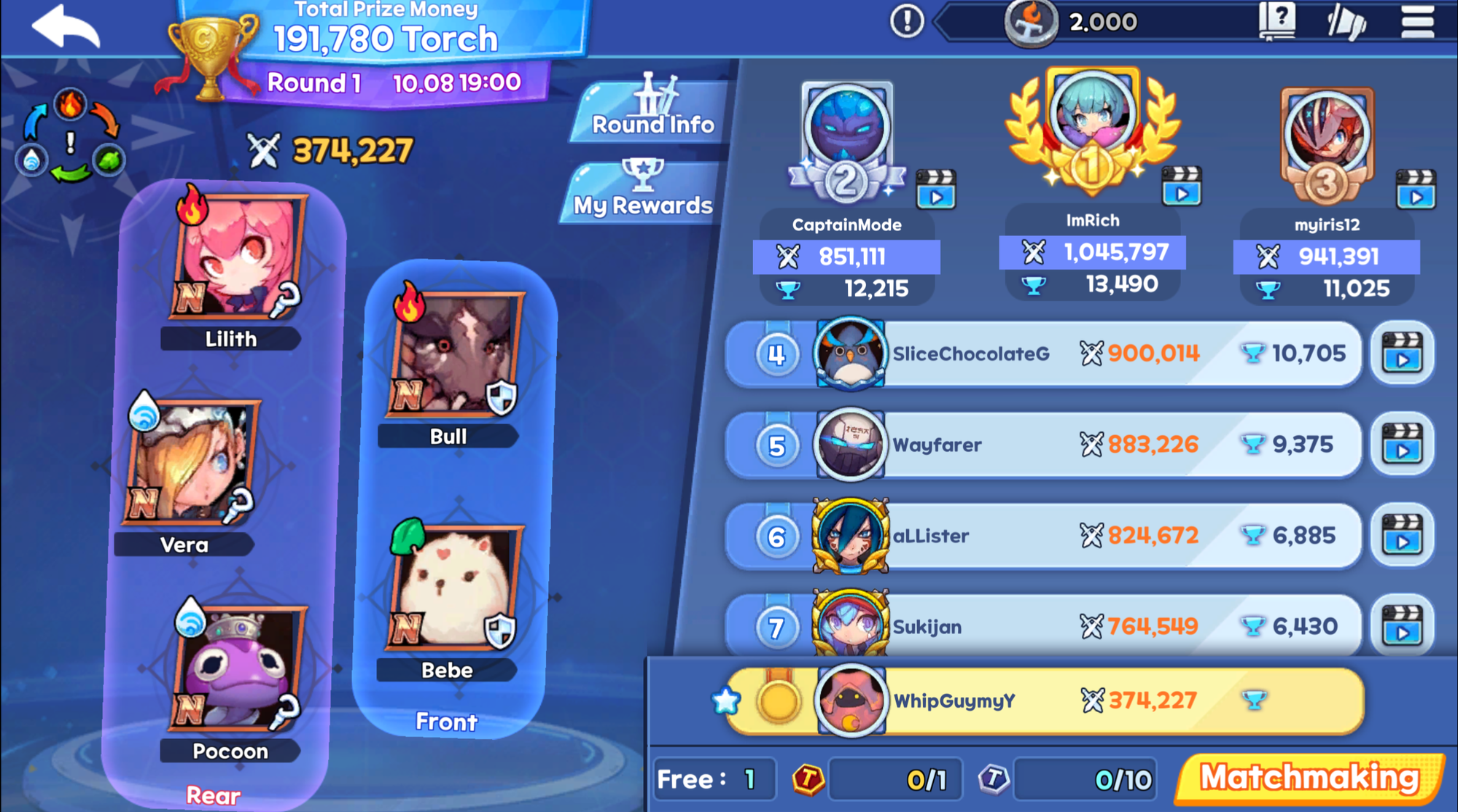
1.3.3 Galactic Shots
This is an additional way to earn $TORCH with relatively little time and effort. Users can set how much $TORCH they want to bet, and if they escape by touching the screen before Pengss stops, they will receive a reward proportional to the distance Pengss has traveled.
1.3.4 Fishing
You can organize a combination of Clashmons to go fishing, and then exchange your catch for $TORCH.
In my personal experience with the game, I found it to be very much about strategy and team building. Each Clashmon has its own attributes, stats, classes, and skills, and it's interesting to think about who to include in your team and how to arrange them to create the best team. The game progresses by participating in various contents with the created team, earning $TORCH and Mystery Boxes, using those resources to summon new Clashmon, and building the optimal team again. The game is easy to play with auto-play, but the overall look and feel of the game is more suited to mobile gaming than PC.
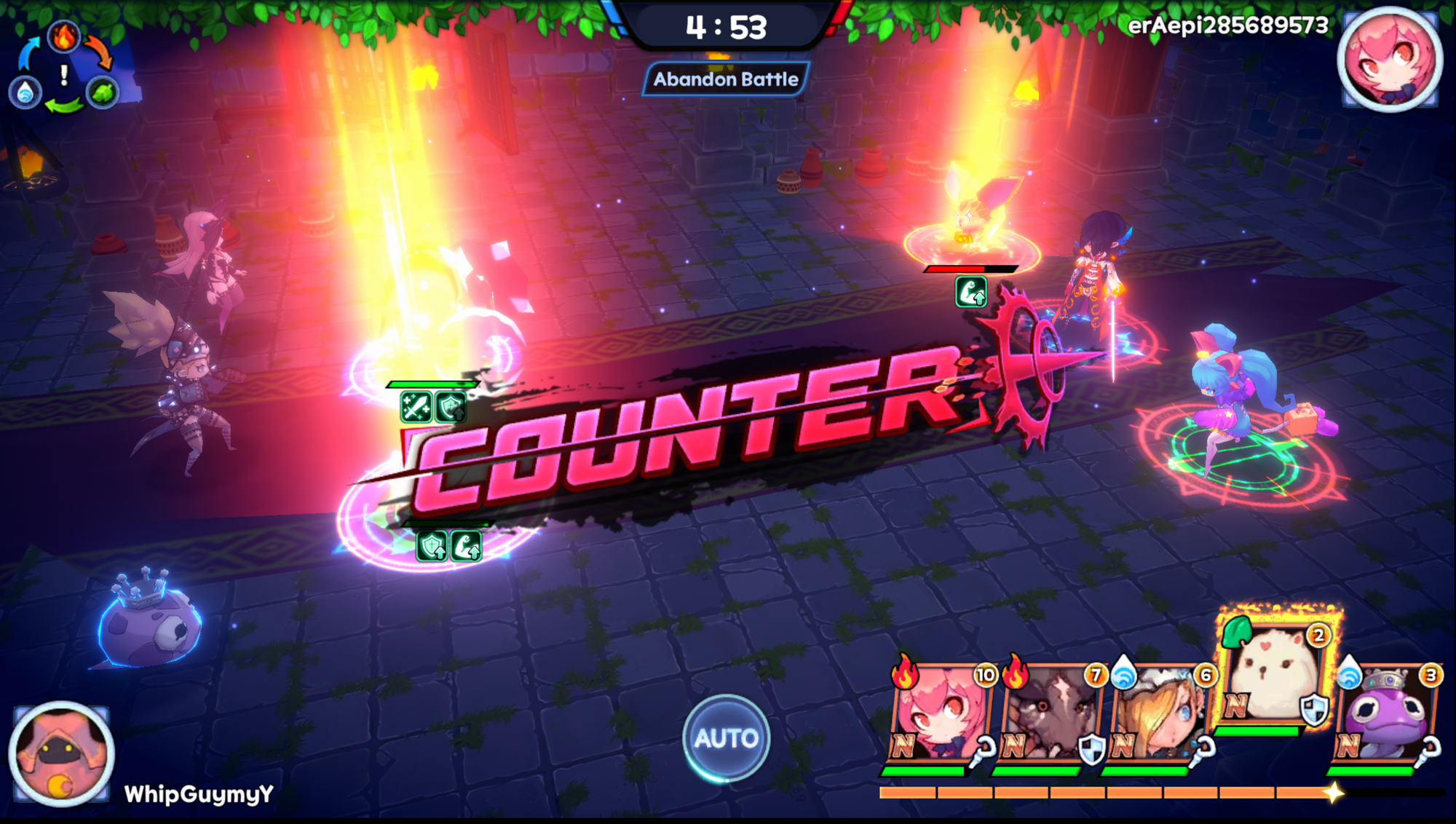
1.4.1 Clashmons
Only tier 4 and above Clashmons can be converted to NFTs and traded on the marketplace. A deck consists of a total of 5 Clashmon, which can be summoned from the store or purchased from the ISKRA Marketplace or OpenSea. There are more than 700 different types of Clashmon, and they can be synthesized to create higher tiers of Clashmon.
1.4.2 $TORCH
TORCH is the core in-game currency of Clashmon Ignition and can be earned through various gameplay activities.
1.4.3 $AGNI
Although not yet finalized, $ARNI is a governance token in the Clashmon ecosystem and is expected to be used for community incentives, ecosystem expansion, investment, etc.
Basically, you can earn $TORCH by 1) being in the top ranking in the Championship, 2) winning the Arena, 3) catching fish through fishing, 4) winning the Galactic Shot, or 5) hiring miners to mine $TORCH through billing, as introduced earlier.
$TORCH can be used to 1) purchase items in the Shop or to summon new Clashmon, 2) stake them to earn Krypton or Ruby Stones, or 3) pay to participate in major content.
Newly summoned Clashmon can be used to 1) join your Deck, or 2) earn Gold Tickets by staking them.
Krypton and Ruby Stones can be used to synthesize or enhance your existing Clashmon.
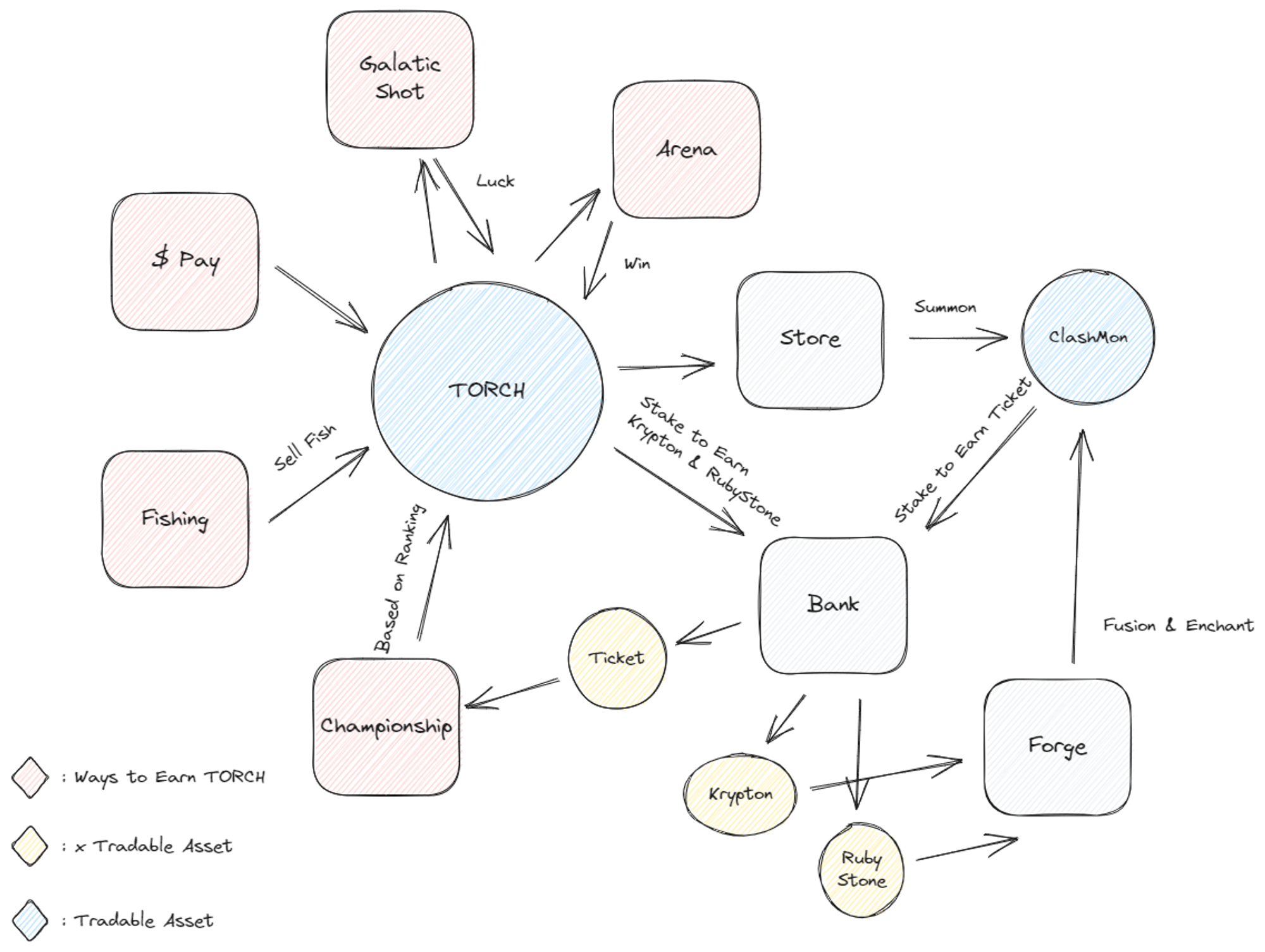
Overall, Clashmon Ignition is a game about collecting Clashmon, building decks with the optimal combination of Clashmon, and participating in content like Championships and Arenas for monetary rewards. Clashmon Ignition is completely free-to-play, meaning you don't have to pay to play, but players looking for big rewards may need to pay to summon stronger Clashmon. Both Championships and Arena use the Risk to Earn (R2E) model, where only the winner or top ranked players can earn rewards, rather than the traditional P2E model, which is expected to provide much more sustainable rewards.
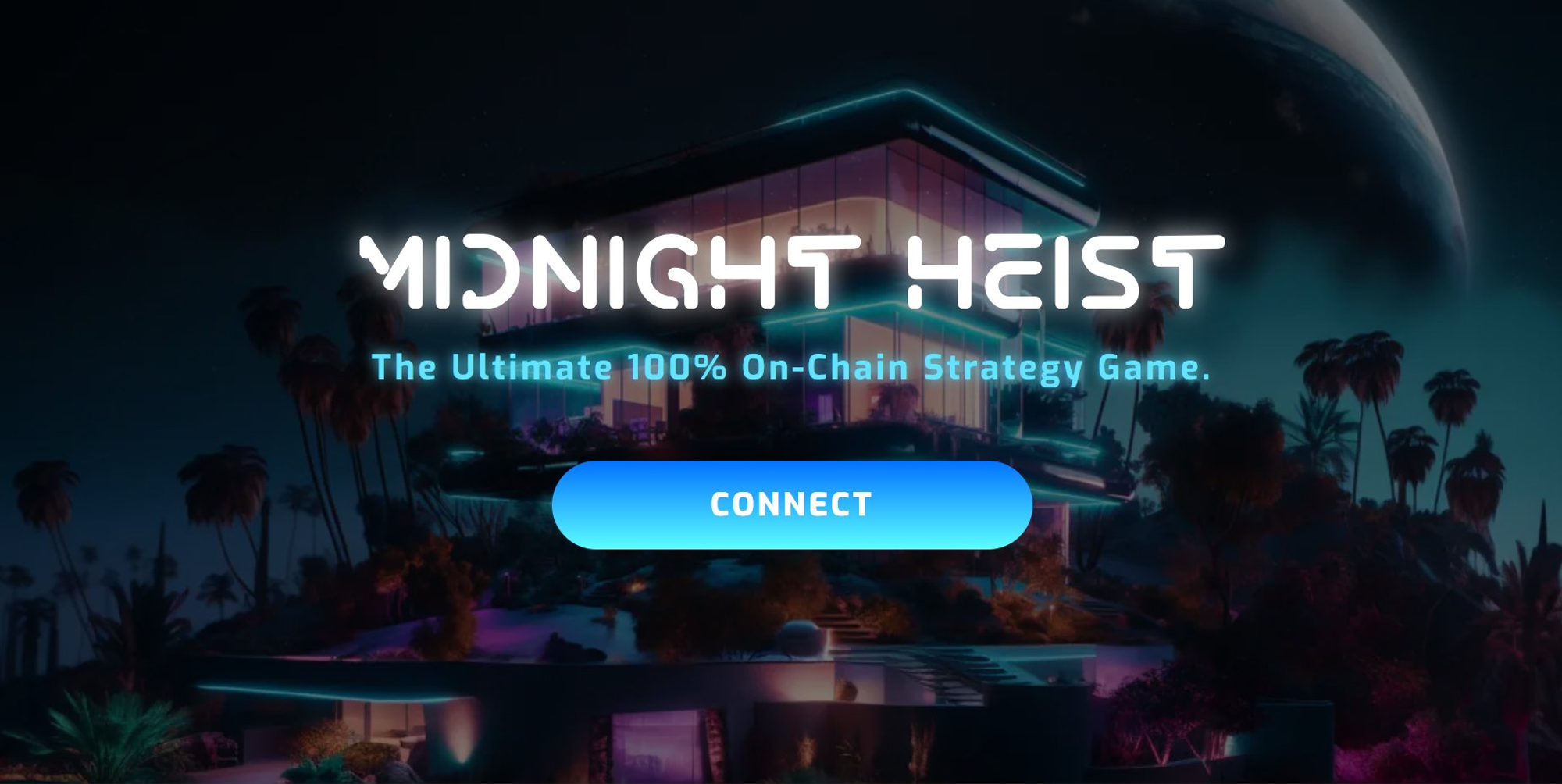
Midnight Heist is a Fully Onchain Game, which can be described as a Rainbow Six Siege-inspired TFT (tactical team combat) game. The goal of the game is to defeat your opponent by assembling a team with the right combination of teammates, weapons, and items and strategically placing them on the map, which can be played both offensively and defensively. The game uses Polygon chain and is currently in closed beta.
The team behind Midnight Heist previously created Crypto Raiders and an onchain game called Cyber Stadium.
Crypto Raiders is an onchain dungeon crawler that has been around since 2021. As you complete dungeons, you can level up your character and earn reward points to improve your stats. With these improved stats, you can progress through the game faster and earn more $RAIDER.
Cyber Stadium is a fully onchain game in the PvP auto-battler genre, where each player can fight other players to earn a share of the Cyber Stadium reward pool, and the losing player's NFTs are burned. It is a typical Risk to Earn type of game.
As mentioned earlier, the game is not played directly by users, but rather by assembling a team, strategizing, and waiting for the results. This is reminiscent of Shoshin and TFT games introduced in the previous month, but the difference is that you go in to attack the opponent's home base, as the title suggests, so it has a Rainbow Siege Six feel to it. The game has three main phases: draft, planning, and battle.
The Draft phase is where you pick characters, called Operators, and weapons and gadgets to build your team. You will randomly draw a total of 6 Operator cards, 10 Weapon cards, 10 Armor cards, and 20 Gadget cards, of which you can redraw up to 3. Finally, you will discard 2 Weapon cards, 2 Armor cards, and 4 Gadget cards to end the draft.
Each Operator has a class and an affiliation, which determines their role. For example, Assassins are attackers, Sentinels are tankers, and Engineers are supporters, but there are multiple Operators within each class, each with different skills. The more Operators of the same faction you have, the more statistical bonuses you will receive together.
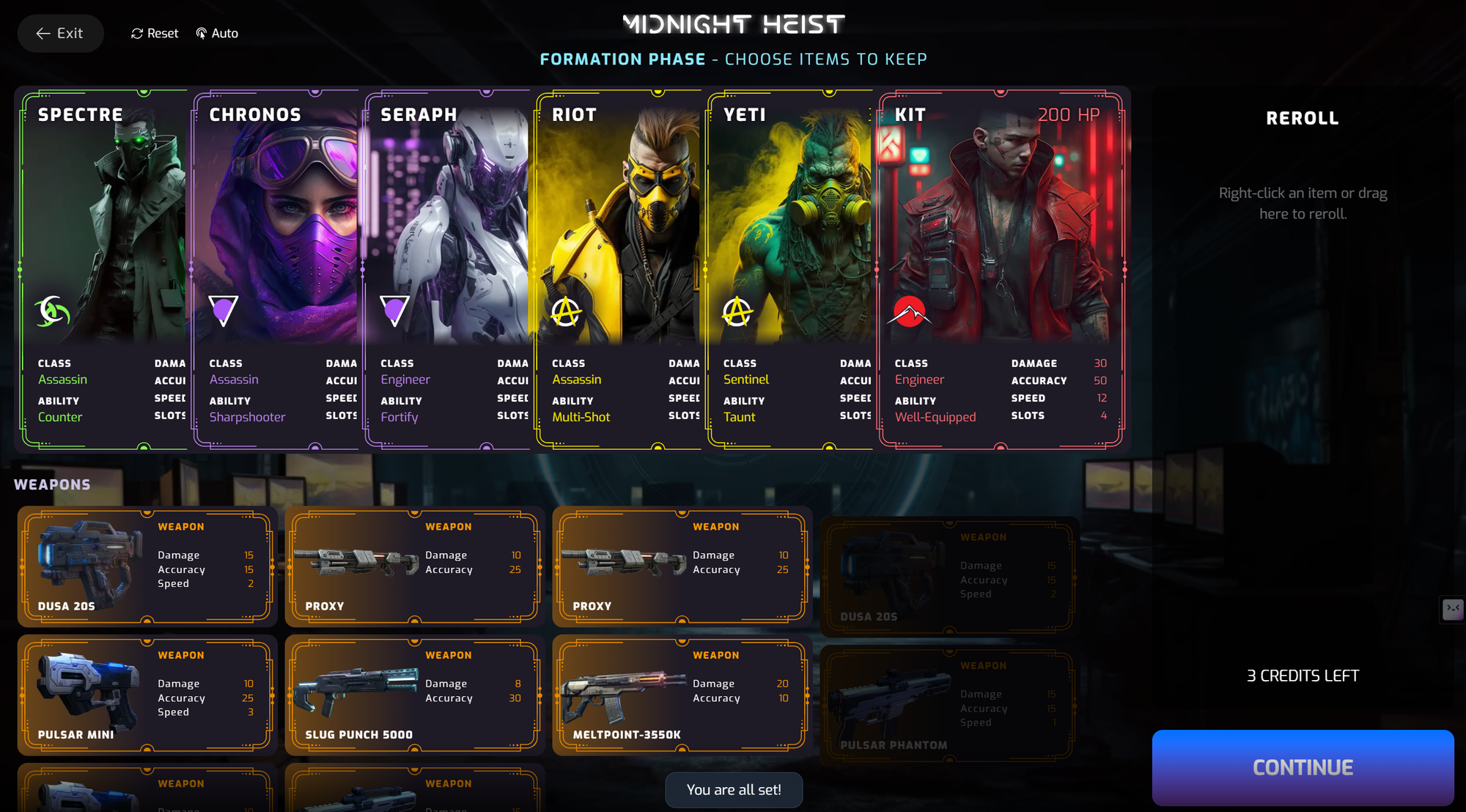
Once the draft is over, the planning phase begins. This is where the player decides where to place each Operator on the map and when to use their gadgets, or items. This is a crucial step, as it can mean the difference between winning and losing a battle, depending on which characters are placed in which rooms of the map and with whom.
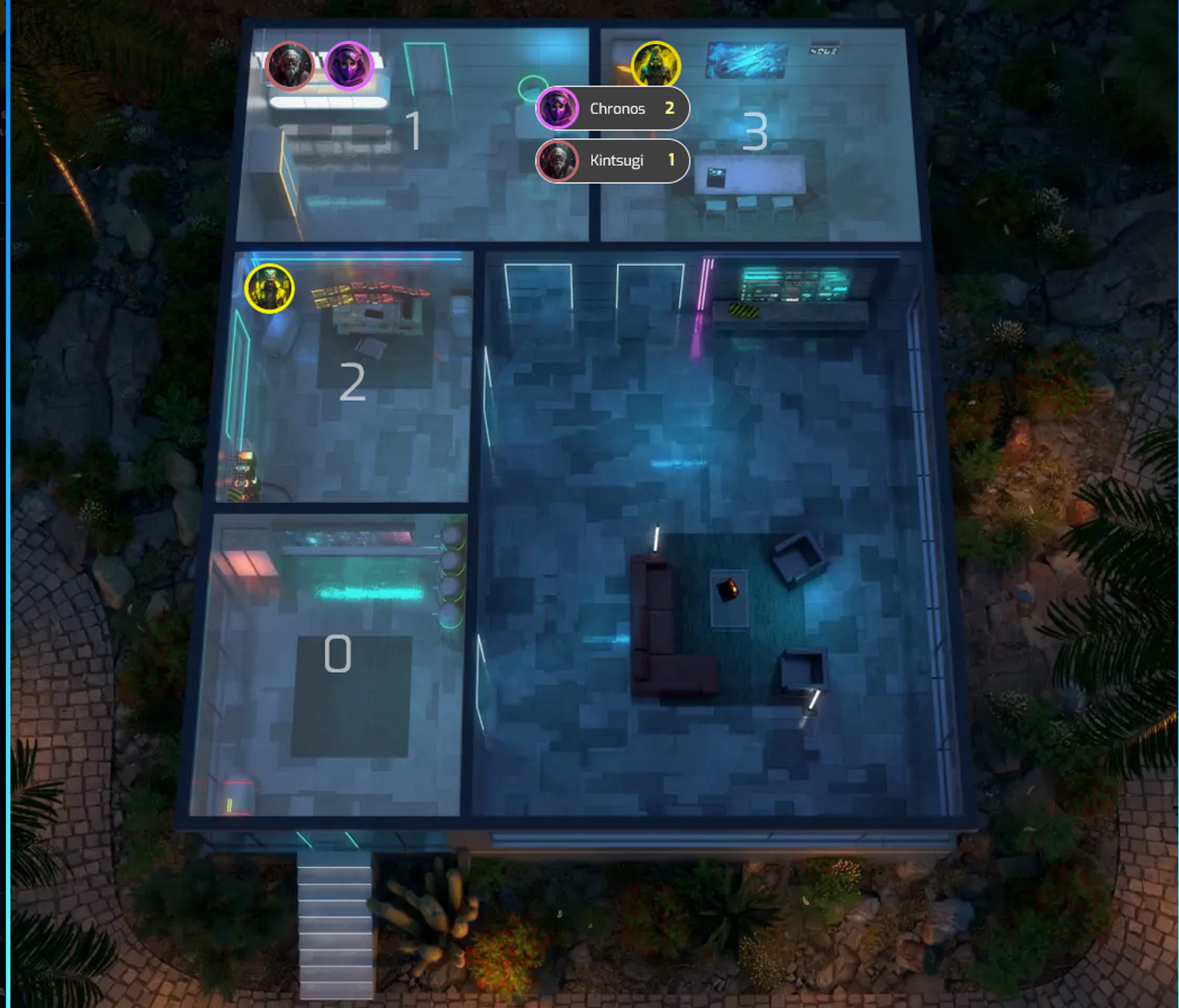
The actual battle takes place asynchronously, with the operators moving and fighting each other according to the conditions I set. You can see this in the simulation video later.
After playing the game, I think it's a fun game for TFT fans to play. First of all, there are a lot of strategic elements to the game, such as which operators to pick during the drafting and planning phase, what items to equip each operator with, and where to place them on the map. However, if you're looking for a fast-paced game, or someone who gets a lot of enjoyment out of playing hands-on, TFT is definitely not for you, and I wouldn't recommend Midnight Heist.
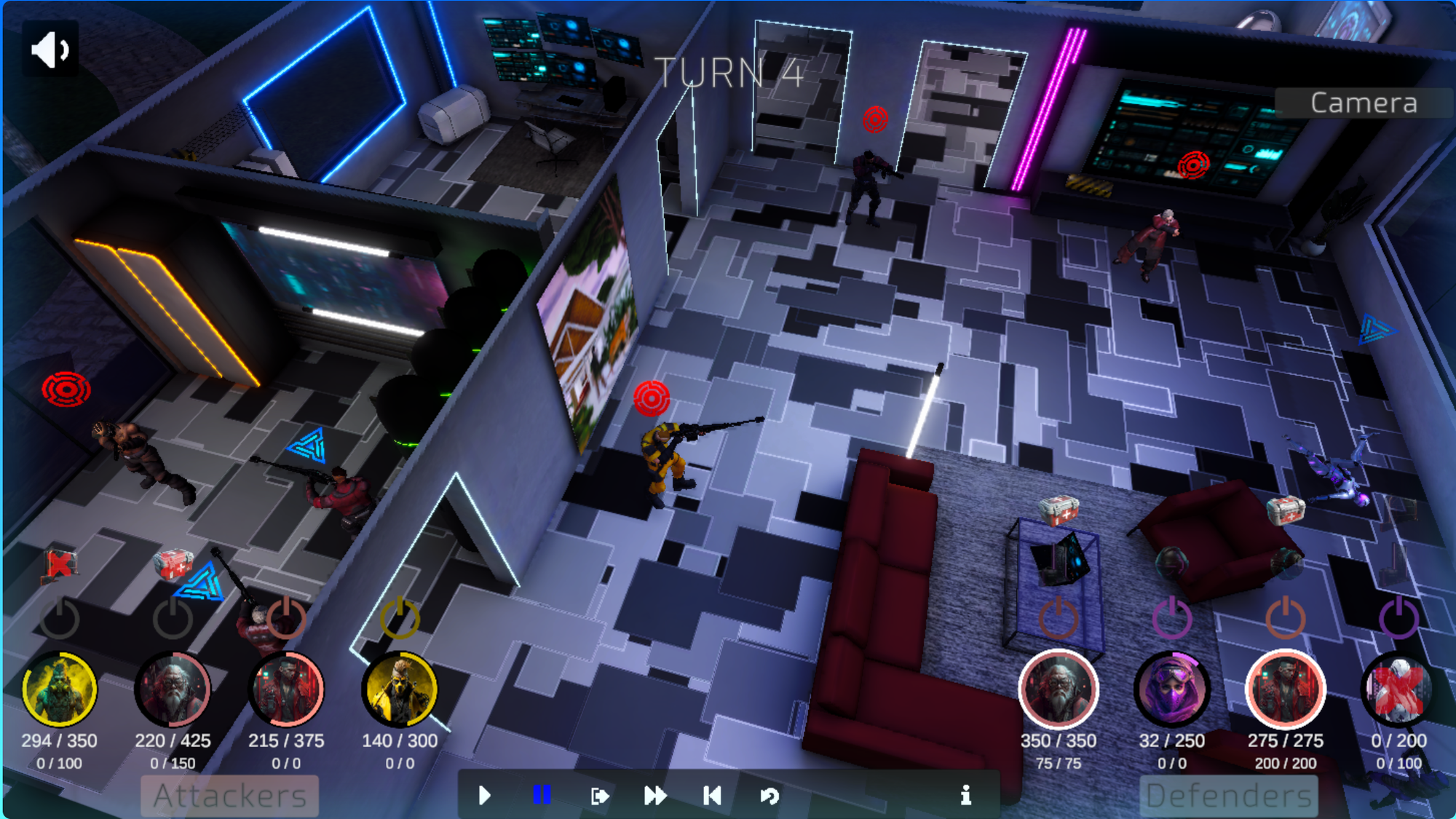
First of all, the contract is not public, but as a FOCG, every action from drafting cards, creating a vault, and attacking an opponent's vault requires a signature and a gas fee. Maybe it's because it's still in closed beta, but I don't see the benefit of going FOCG right now. However, it's something to keep an eye on.
There are currently two game modes in Midnight Heist: Quick Match and Vault Mode. Essentially, both game modes use a Risk to Earn approach, with Quick Match using a traditional PvP R2E model where two players stake against each other and the winner takes all. Vault Mode is a bit different.
In Vault Mode, players first create a vault, deposit some funds into it, and complete the Draft & Planning process described above. Players who wish to attack the vault then wager a certain amount of money to enter the battle and, if successful, take a portion of the funds deposited in the vault; if unsuccessful, they lose their wager.
Midnight Heist is a FOCG that adds a fresh concept of heists that should appeal to those already familiar with TFT. After participating in the closed playtest, I think it is a game that can be enjoyed if you have the right personality, and in terms of UX, it is inconvenient that features such as session keys are not used, so you have to sign tx and pay for gas every time. In terms of BM, the active use of R2E mechanisms is a positive factor, but I still don't see a clear rationale for designing the game as a FOCG.

Stella Fantasy is a subculture collectible ARPG created by Ring Games and is currently available on both PC and mobile. It uses the BNB chain as its underlying chain, and is currently available to everyone with a global launch on April 13, 2023.
Stella Fantasy was created by Ring Games, a company founded by the main team behind King's Raid, which was released in 2017 and has since reached 10 million downloads in 150 countries worldwide. While servicing the previous game, Ring Games decided to create an onchain game to communicate more directly with users, and in the case of Stella Fantasy, development began in 2019. In September 2022, Ring Games raised approximately $5M in funding from Animoca Brands, Planetarium, DeFiance Capital, Play Ventures, and Double Peak.
The core gameplay of Stella Fantasy is combat. A total of four characters can be organized into a party to participate in battles, with the user controlling one character and the AI controlling the rest. Stella Fantasy has the following combat content.
Main Story Progression: This is the main story that starts with a typical "Where am I...?" and follows the storyline of the characters in Stella Fantasy, and as you progress, you will naturally level up your character and get various materials to craft weapons.
Abyss Rift: Users pay a certain amount of resources to enter the Abyss Rift and are rewarded with things like $SFTY, resources, character shards, and Manarings. Each stage has different levels of difficulty, and the harder the stage, the greater the reward.
Abyss Invader: You earn points for the damage you do over a period of time, and you're rewarded based on your score in each round.
I found the combat to be easy and impactful, and since you have a party of four characters, it's fun to switch between them and use their unique skills in battle. The overall story progression is kinda reminds me of visual novel, and as a Korean player, I was disappointed that it wasn't available in Korean. During combat, there were a few bugs that caused the viewpoint to lock on in an awkward way at times, and I felt like the AI could have been a little smarter. For example, there were times when it couldn't dodge things that you'd think it would dodge, so even though there were four players, it felt like there were only 1.3. However, I also wonder if people who are good at the game will be able to switch characters quickly and do well.
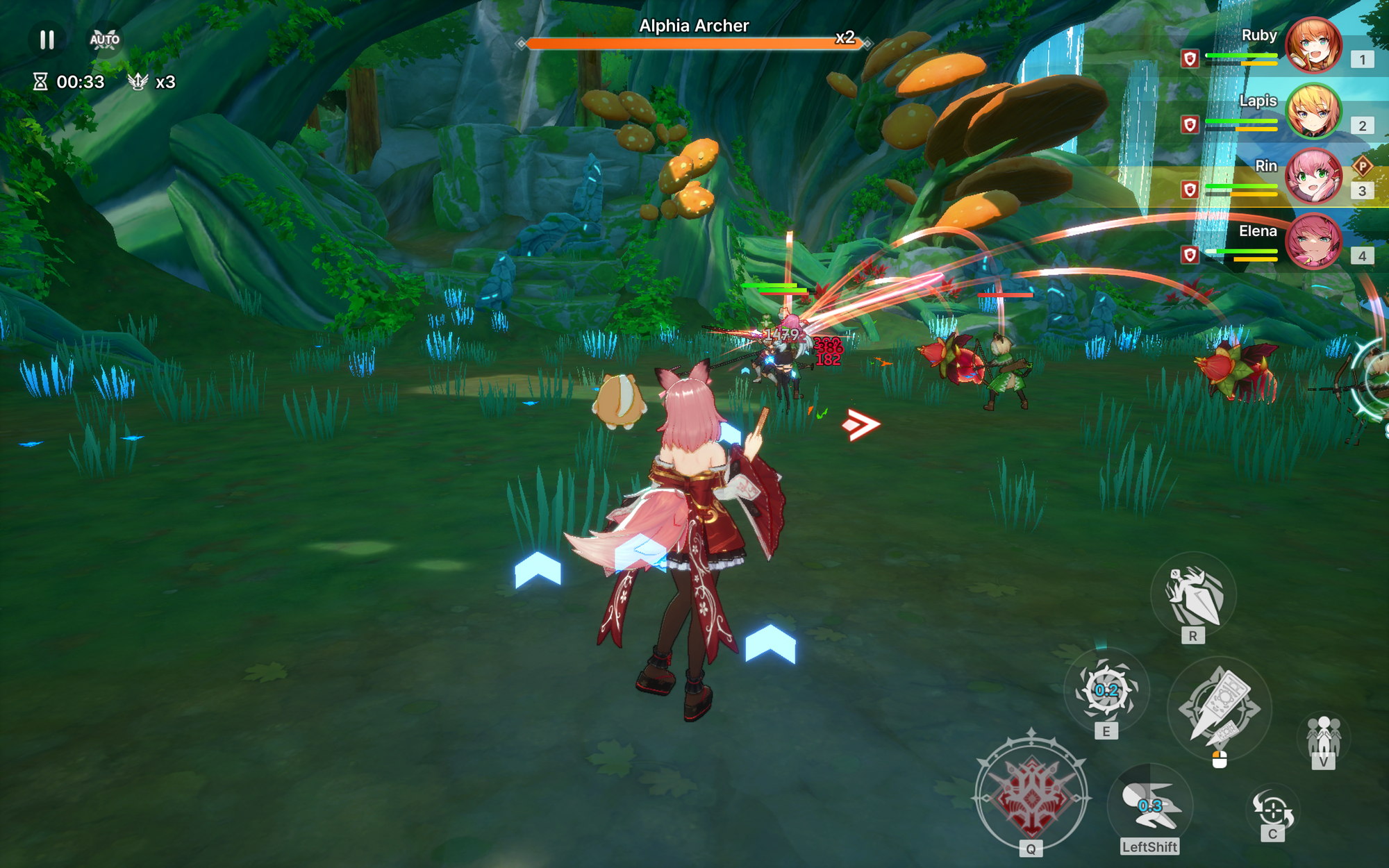
As you progress through the main story mode, there comes a point where you can't progress any further with the default characters, and you need to start crafting weapons or recruiting new characters. For me, this was during Stages 1-9, and I purchased a character from the Marketplace to keep things flowing. Currently, the Marketplace is implemented as a separate website outside of the game and can be purchased with BNB. Personally, I found the unique design of the characters and the difference in power after purchase to be satisfying enough to justify the expense.
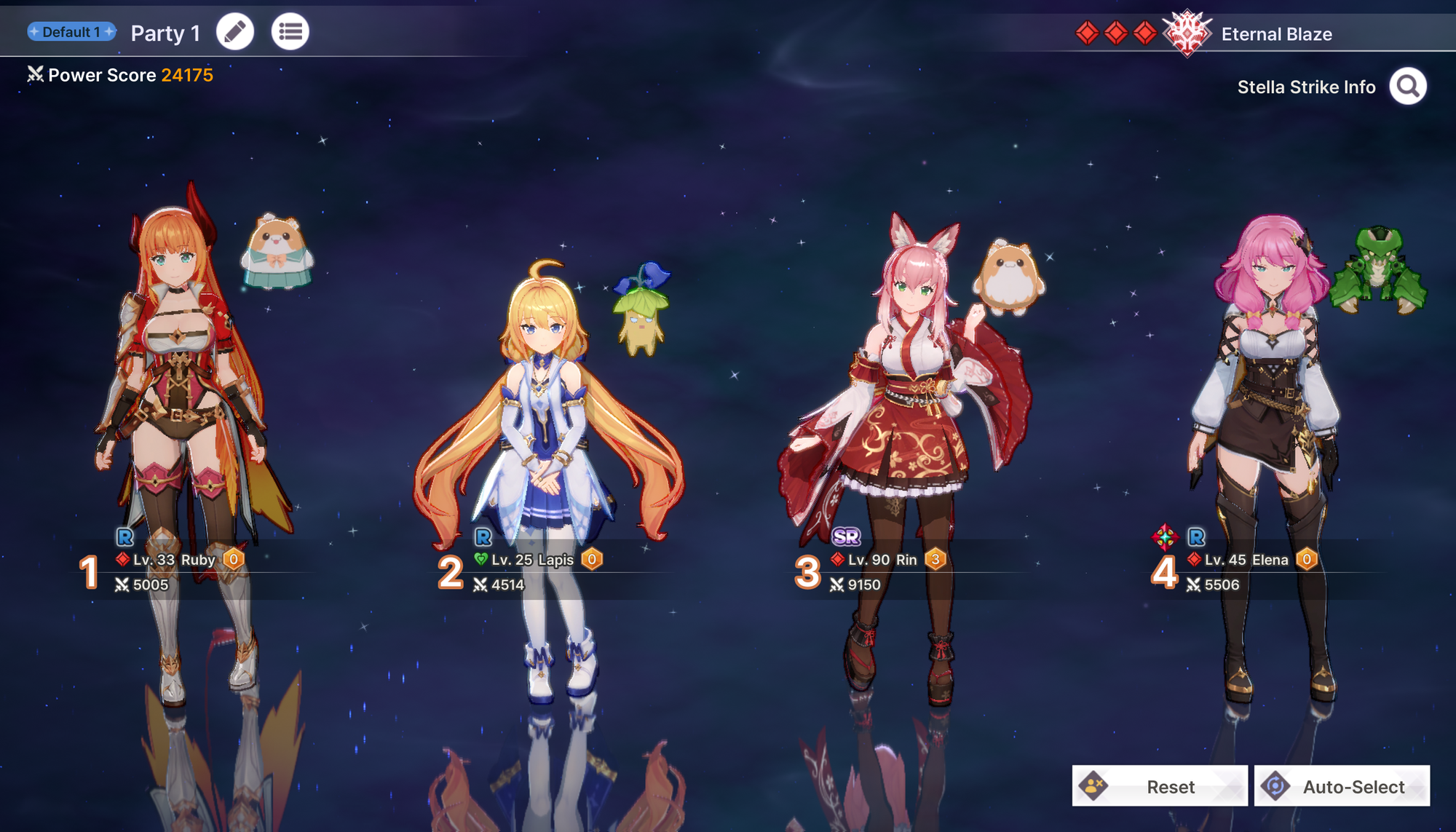
I also played the mobile version of Stella Fantasy, which was released in August 2023, and I was very disappointed that it had to be downloaded from the website in the form of an APK file. However, the gameplay itself in the mobile version was good, first of all, there is a full auto mode, so you can play the game more comfortably by running the auto mode and only dodging attacks or using skills when you are in a hurry. The overall graphics, UX, and latency of the game were also very good compared to the PC version.
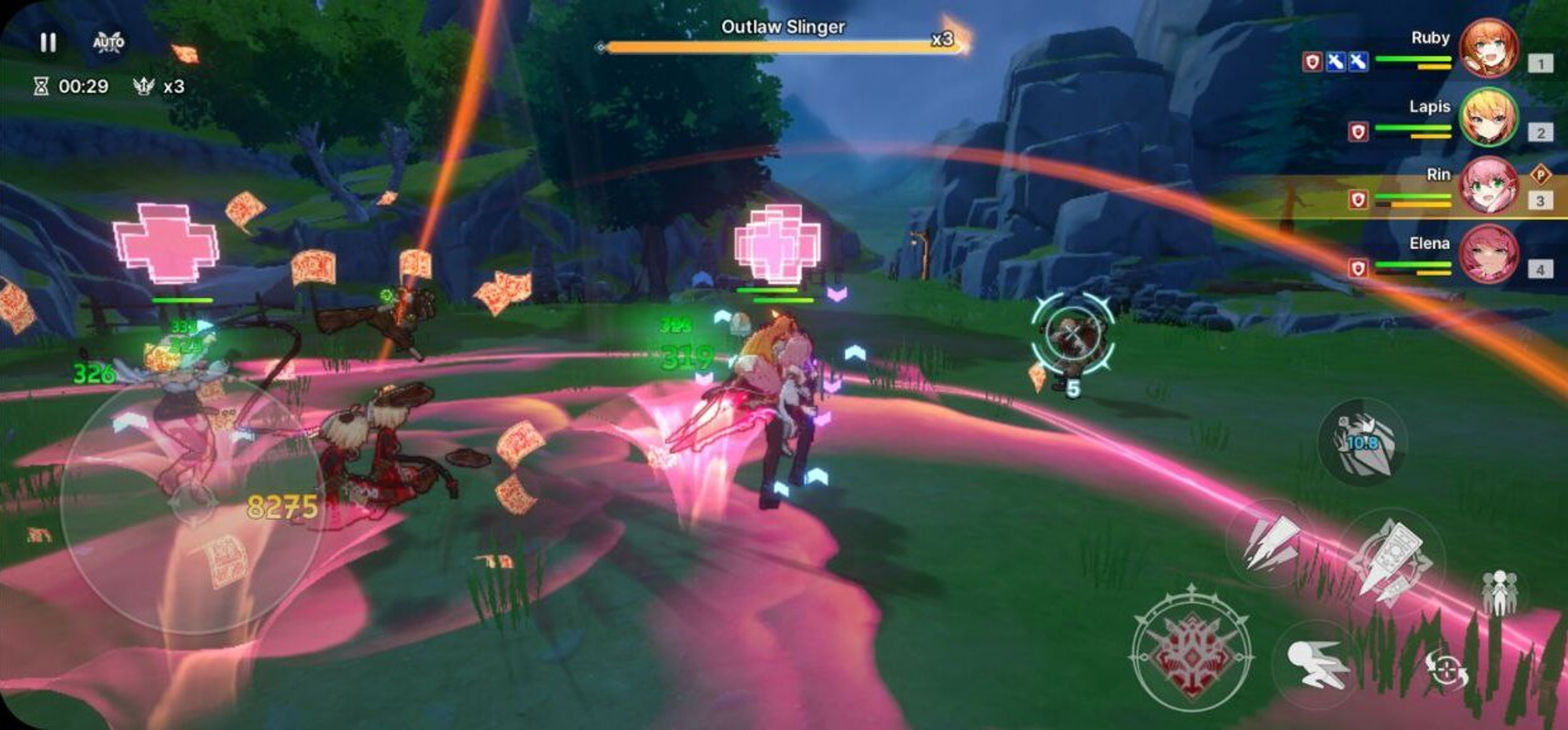
Stella Fantasy is a typical Onchain Asset Game, where the core game logic is off-chain, but things like characters, equipment, and runes are implemented as NFTs, and $STFY, one of the in-game currencies, can be traded outside the game.
3.4.1 Characters
Players will need to build an optimal battle party of 4 characters to progress through the story and win various content. There are three main ways to acquire new characters: purchase them in the Stella Shop, receive them as rewards in Abyss Rift, or purchase them from other users in the Marketplace. Each character has a variety of attributes, including attack types, elements, and unique skills, including stats that affect combat and non-combat stats that affect item crafting and resource gathering. As in other RPG games, characters can be leveled up and awakened through certain resources.
3.4.2 Gear
Players can craft gear using resources from their lands and items from battles, and equip it to their characters to improve their stats. Higher tiers of gear require rarer resources and can be traded through the Marketplace. Each piece of gear has one unique attribute and four random attributes. Due to the randomization, each piece of equipment has a unique value.
3.4.3 Runes
Recently updated, Runes can be equipped on characters just like Equipment, but unlock additional special set properties and more.
There are two types of in-game assets in Stella Fantasy: Manaring and SFTY.
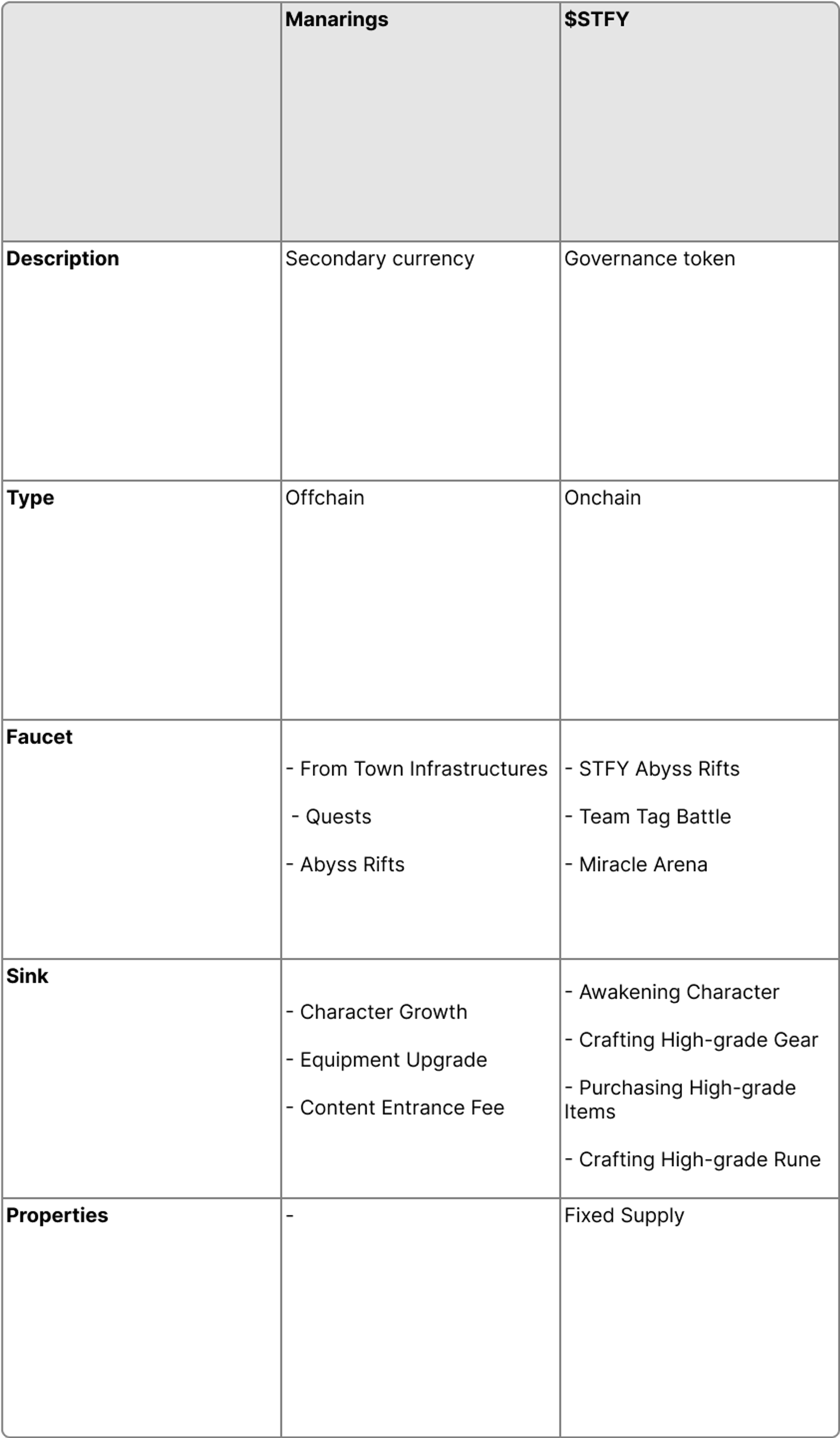
Stella Fantasy has a P2E component, but I didn't really feel like it was a big part of the game, and it felt more like a subculture RPG where you can buy characters with crypto and use them in-game. Personally, I was happy with it, and I'll probably play it from time to time in the future. One thing I should mention is that I haven't played many other subculture games, so I can't really give an objective assessment, so it might be different for players who are familiar with those games. But for me, it wasn't bad.

Primoidum is a Fully Onchain Game similar in style to Factorio, where the player has to think about how to efficiently mine resources and what facilities to build with them. Currently, it appears to be using a rollup as a service tool called Caldera, with over 4,000 wallet addresses and about 7M transactions, according to Block Explorer. No official launch date has been announced yet.
The creators of Primodium, @intemerson and @tax_cuts, are brothers who started their careers as web2 developers building mobile games and social applications. They founded and sold Palifer, a YC-backed LLM company, in 2022, and chose web3 as their next industry challenge. Their first project on web3 was Critterz, a P2E Minecraft server inspired by the Nouns DAO, which was shut down when Minecraft banned NFTs. Afterward, they became interested in a Fully Onchain Game, which eventually led to the creation of Primodium.
At the start of the game, users are assigned their own asteroid, where they set up their base. From there, they extract resources such as iron, copper, and lithium. Your ultimate goal is to use these resources to expand your kingdom by upgrading existing facilities or building new ones. You can also produce units to explore nearby asteroids, and recently, PvP was added so you can attack other people's bases and loot their resources. To do this, you'll need to provide electricity through solar panels and build facilities like drone factories and hangars. After attacking an external asteroid or another user's asteroid, you can see the results in the Battle Reports tab.
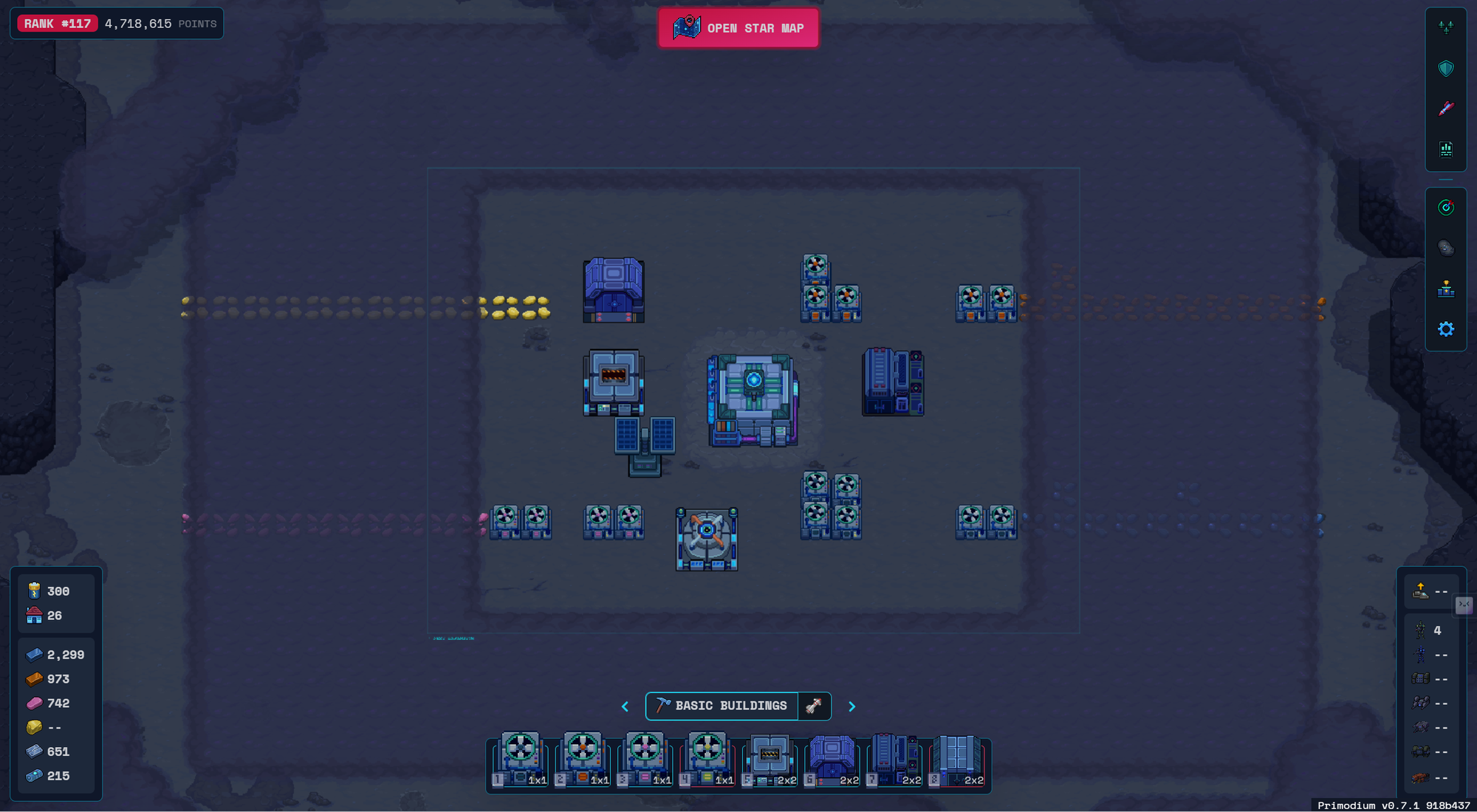
In my time with the game, I found it enjoyable to collect resources, construct buildings one by one, and produce units to attack other asteroids. The gameplay is not very fast-paced due to the nature of the game genre, but if you don't mind that and don't mind playing at a leisurely pace, I think anyone can have fun with this game. Also, as a beginner, I would recommend watching the provided tutorial and solving the quests in the Objective menu one by one to better understand and enjoy the game.
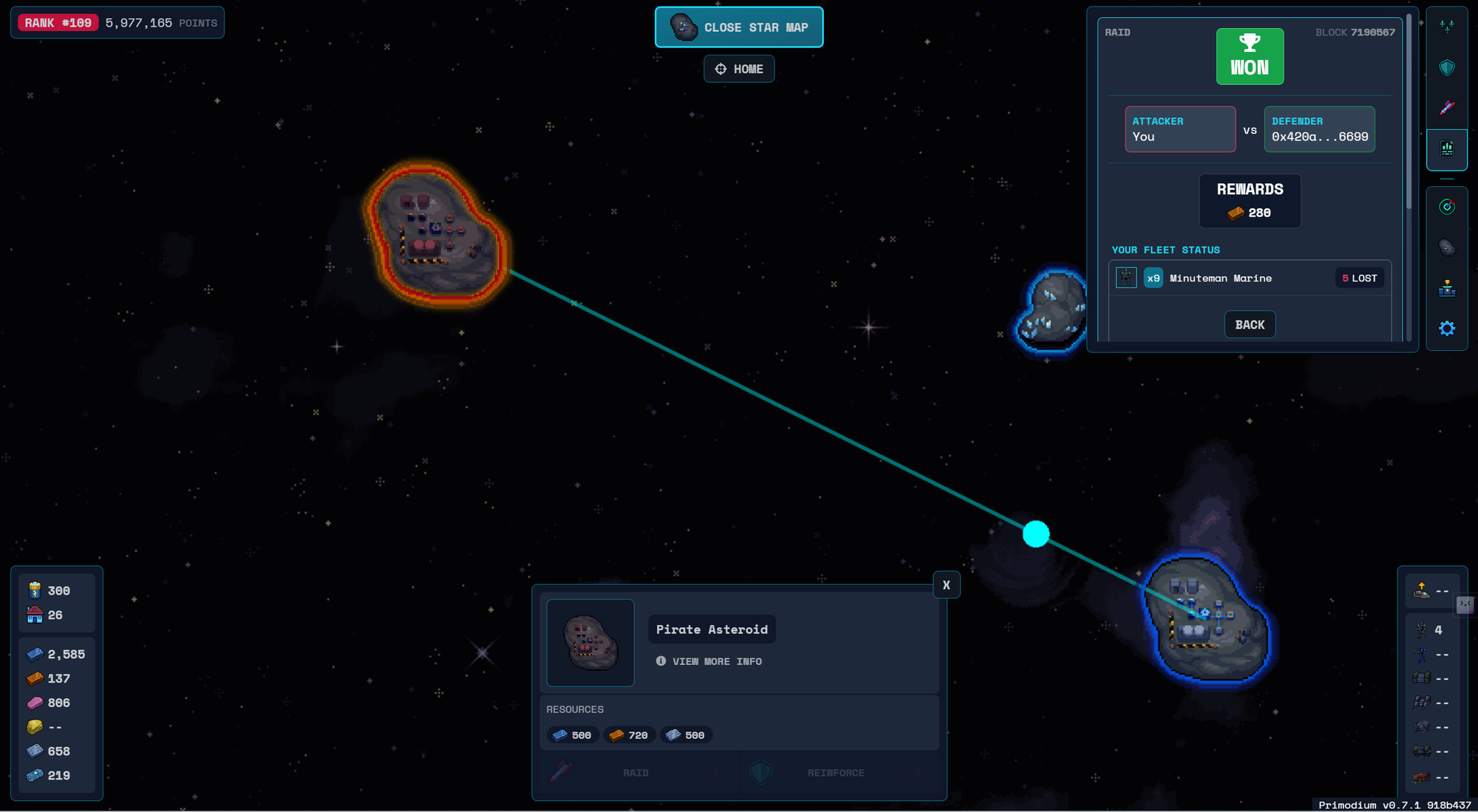
Although the code is not publicly available, Primodium is a Fully Onchain Game using a MUD framework, meaning that all game assets and logic are implemented on-chain. The burner wallet also allows users to enjoy the game without signing every transaction.
As a resource management game, there is an in-game economic model, but it is not currently connected to the economy outside the game.
Primodium is a static game that can easily get boring, but the recent addition of PvP has made the game much more interesting. The game's elements of resource mining, strategy, and PvP combat all work together seamlessly, and the depth of the game's content is endless.
To summarize, Primodium is a game where new elements are discovered the more you play, and if you've enjoyed playing traditional Factorio or tycoon games, you'll likely enjoy playing it as well. The gameplay flow is so natural that the average user won't even realize that all of the game's logic is implemented on-chain.
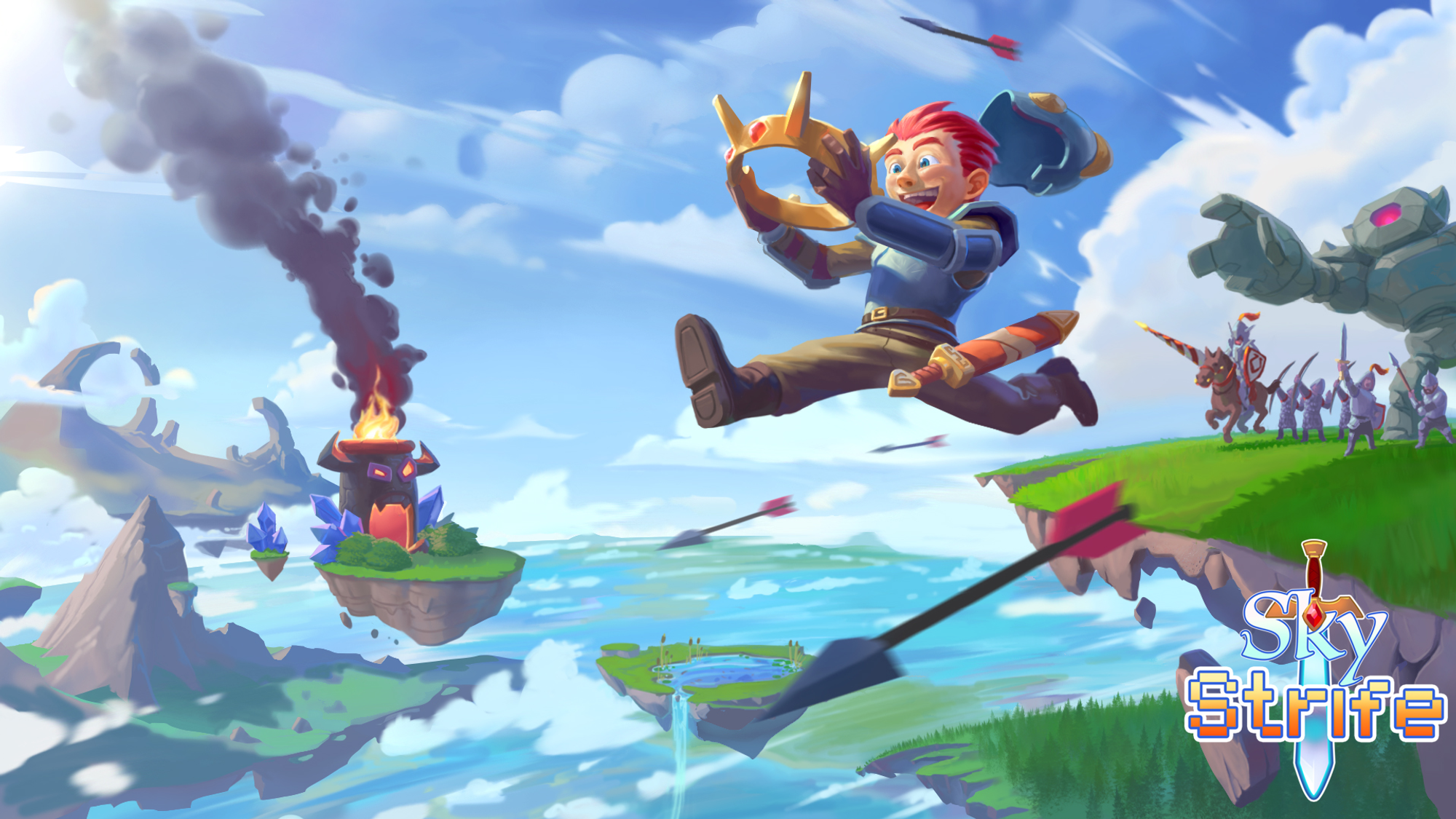
Sky Strife is a turn-based real-time strategy game for up to four players, where the goal is to defend your base while destroying your opponent's base. Sky Strife has not been officially launched yet, and recently went through a two-week playtest, using its own testnet.
Lattice, the creators of Sky Strife, is an engineering and production company that strives to push the boundaries of the Ethereum ecosystem. Lattice's most notable work is the MUD, an open source framework for developing onchain applications, including Fully Onchain Games. Sky Strife was built using MUD, and last year the company released MUD and OP Craft, an on-chain implementation of Minecraft using the OP Stack. OP Craft attracted over 3.5M transactions in 10 days and over 1500 players. The team is currently working on MUD v2 and has successfully hosted various research content and hackathon events in addition to development.
Each player starts the game with their own base, hero, and 1000 gold. With this gold, players can summon various types of units, with the ultimate goal of destroying the opponent's base. Here is some information about each unit.
Hero: The player's initial unit, which is powerful but cannot be summoned further.
Swordsman: The most basic unit, with the worst stats and defense. They can be summoned for 500 gold.
Pillager: A highly mobile unit, but with a very weak attack. It costs 700 Gold to summon.
Knight: A highly mobile unit alongside the Pillager, with high attack and average health. It can be summoned for 900 Gold.
Archer: A ranged attack unit with high attack power and low health. It can be summoned for 1110 Gold.
Pikeman: Tank-type unit with high attack and high health, but slightly less mobility. It can be summoned for 1600 Gold.
Units can move or attack once per turn, and each turn lasts 15 seconds. To earn additional gold, you need to secure mines or destroy enemy units or bases.
The first, second, and third place finishers among the four players are rewarded with Orbs, which are used to generate new matches.
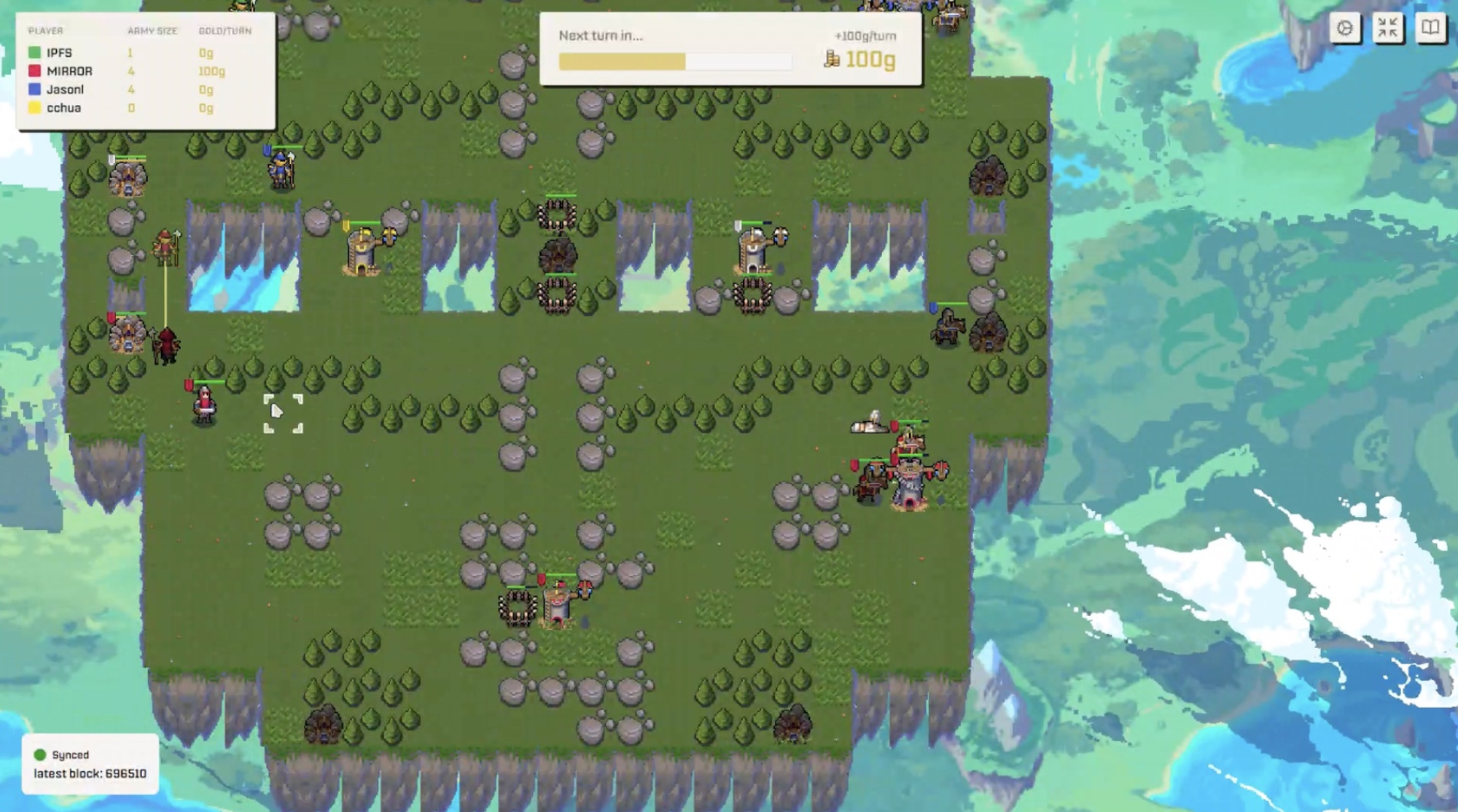
Source: Lattice
Most recently, I participated in the Sky Strife tournament organized by ggQuest x AW Research x PaladinsDAO x Composable Labs. Prior to this tournament, I had only played Sky Strife as an individual, and this was my first time playing 2 vs 2 team. Personally, I think team play is a lot more fun because there are more strategies and more variables that come into play in team play than in individual play. Here's what I learned from my time playing.
The initial build is important. As with any strategy game, what units you draw and what objectives you target early on will have a huge impact on the game. A common build is to summon fast units early on and then go for the mines, but I think there's a lot of room for variation.
15 seconds is not as long as it seems. As the game progresses past the mid-game, there are more and more units that need to be moved, and it's not as easy as you think to move each unit to the optimal position and attack the enemy in 15 seconds. Therefore, it's a game that requires more physical skills than you think.
A lot of matches can be won or lost in a single move. In my experience, many matches can be decided by one or two units. Mines also don't give gold after a certain period of time, so gold becomes really valuable in the later stages of the game, and whoever is the first to destroy their opponent's units and get extra gold can make a big difference.
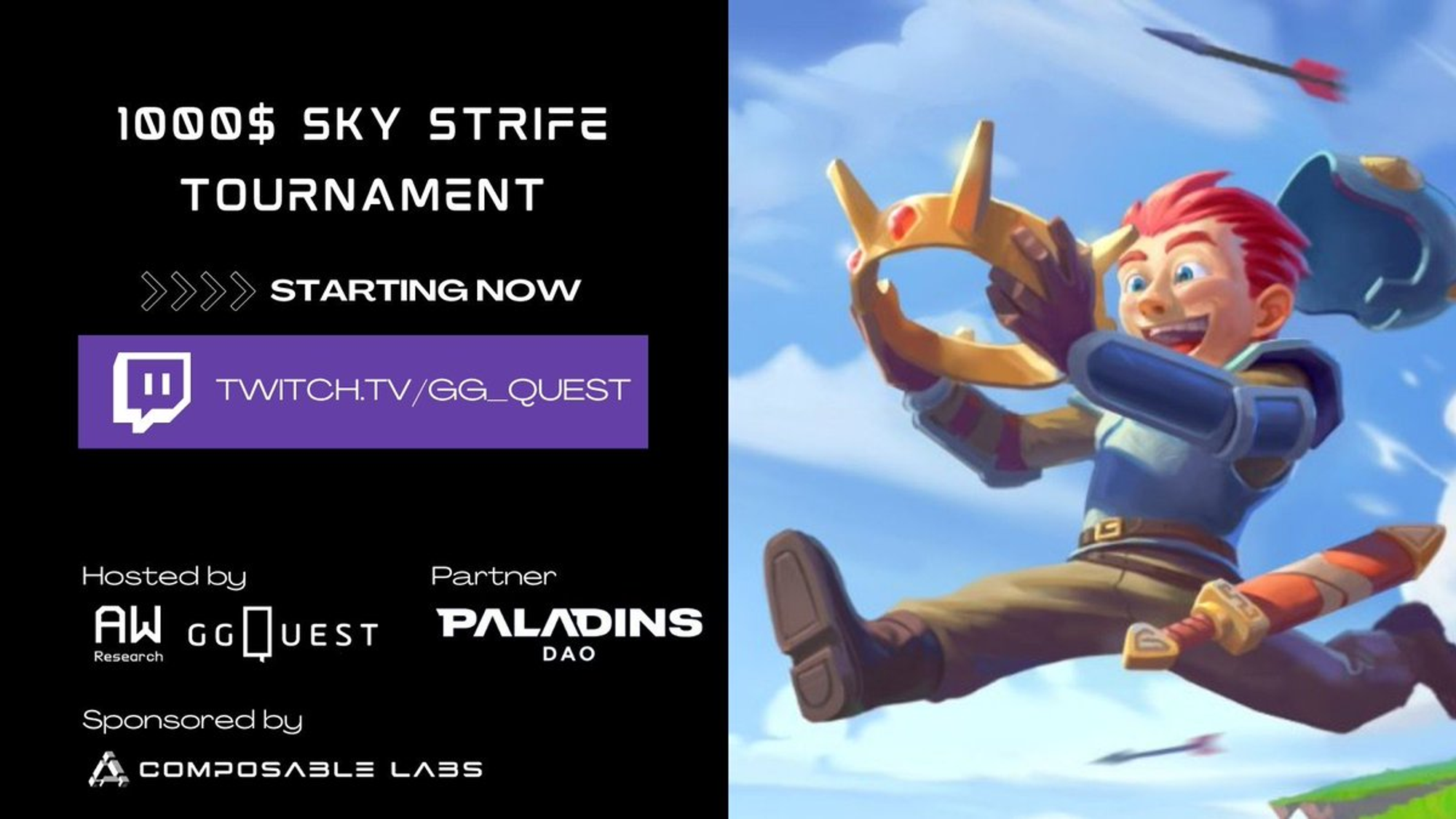
Source: ggQuest
While the full code is not yet publicly available, so we don't know the exact logic behind it, Sky Strike is a FOCG built on top of a MUD, with all game assets and logic implemented onchain. Like other FOCGs, it uses burner wallets to allow users to play without the hassle of signing each turn. Sky Strife is client agnostic, which is a unique feature of FOCGs, and provides a guide to create your own Sky Strife client.
No economic model exists at this time.
Sky Strife has garnered a lot of attention for its early use of MUDs and continues to improve through playtesting and user feedback. As one of the most fun FOCGs I've ever played, Sky Strife is a project I'm looking forward to seeing more of in the future. Rumor has it that there may be a crafting mode where users can participate in the game with their own items, which is one of the things I'm really looking forward to as it would be a great addition to the modding and UGC aspects of FOCGs.
Thanks to Kate for designing the graphics for this article.
We produce in-depth blockchain research articles

We explore the history of various gaming platform categories that have driven the success of the gaming industry, and Iskra's new vision and initiatives for Web3 gaming adoption.

A look back at 2023 in the on-chain gaming industry, and a look ahead to 2024.

Onchain Games I Played This Month: November

This report covers the gaming sector in November 2023.